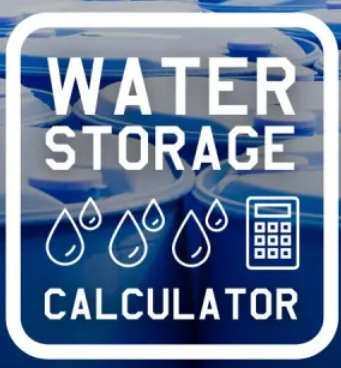Water Essentials
Water is a basic human need and key to survival. Methods to gather, store, and sanitize water are all important but knowing how much water you may need is important as well. Water is heavy and takes up a lot of space when it is stored, so knowing exactly how much you need can help you plan for preparedness.
You can only live a few days without water and you should have a plan to store, filter, and purify it. Water is very heavy at 8.3 lbs per gallon. This poses a problem when creating mobile kits, like a car kit or bug-out bag. In-home survival kits don’t have this problem, so stocking up is one of the easiest ways to knock this element of the kit out. You want water for the entire family for three days. Ongoing water collection solutions are also a great way to tackle water storage, using rain collection barrels or your very own well. Check out our water storage calculator to make all of the math easy:
- Back Stock Your Pantry: Buy extra bottled water to start your water storage plan.
- Emergency Water Storage: Great for disasters, this thing instantly turns any bathtub into a disaster water reservoir.
- Water Filter
- Water Purifier: Iodine tablets for purifying water storage. For being so small and cheap, there is no reason to overlook these in a survival kit.
How Much Water Should You Store for Emergencies?
30 gallons per month, per person, is the consensus of the CDC, FEMA, and most emergency management agencies.
While the amount of water that you need depends on your planned uses, they break down pretty easily:
Drinking- People generally need 15 gallons of clean drinking water per month. Your body is constantly losing water through sweating, digestion, and even breathing. You will need an ample supply of water to prevent dehydration.
Cooking– About seven and a half gallons of water are needed to use for cooking per month. Most freeze-dried food kits require water for rehydration. Water is also needed to activate MRE heaters. Boiling is an effective cooking method that requires water as well.
Washing– Hygiene is important during emergencies, and seven and a half gallons are needed to keep clean, wash hands, and for first-aid use.
If you use the calculator above, you can plan ahead using these amounts to find exactly how much water you need to store.
How Frequently Should Water Storage be Rotated?
The storage container type, condition of the water, and conditions of the storage area all affect how often you should rotate your water supply.
Different types of plastic storage containers are effective for different lengths of time. BPA-free plastics are preferred for long-term water storage because BPA can leach into the water, and BPA mimics estrogen and can affect your body.
Purified and/or treated water is best for storage and would only need to be rotated out every five years. Still, it should be checked for algae growth or any contaminants or murkiness annually. Any sort of film or discoloration is an easy way to tell that you need to rotate the water out.
Water stays best in airtight, watertight containers stored out of sunlight in a room temperature setting. Temperature fluctuations can encourage bacteria growth, compromise the seal on containers (through pressure release), and degrade plastics. If you are not storing water in ideal settings, you will need to check the water more often and rotate it out more frequently.
How to Sanitize Water
Sanitizing water is a very important skill to learn, and is easiest with a few resources. There are many different methods, but most methods revolve around first filtering the water of contaminants and then treating the water- creating a two-step process. Most people treat water with bleach, tablets, or drops- but there are also newer methods using UV light.
Sanitizing Water with Filters
Different types of filters have varying degrees of effectiveness. Filters count as anything from a mesh keeping leaves out of your rain barrel to a sophisticated reverse osmosis filter. Even high-filtration devices (like osmosis filters and survival filters) will need treatment when preparing water for long-term storage. Water storage needs to be treated to prevent growth, not just to immediately provide clean water.
Sanitizing Water with Bleach
Using typical household bleach (non-scented), the amounts the CDC recommends depend on whether the water is clear or cloudy.
| Amount of Water | 1 gallon | 55 gallons | 300 gallons | 1000 gallons |
| Bleach for Clear Water | 8 drops | 2 1/2 tablespoons | 3/4 cup | 2 1/2 cups |
| Bleach for Cloudy Water | 16 drops | 5 tablespoons | 1 1/2 cups | 5 cups |
Using household bleach (non-scented) with 5.25 – 8.25 chlorine content.
Bleach is a versatile chemical for emergencies, making it one of the preferred water treatment methods.
Sanitizing Water with Tablets or Drops
Purification tablets or drops make water sanitization even easier. Potable Aqua is the most common tablet brand and our top-reviewed choice. The treatment tablets act quickly with water ready to drink in 35 minutes.
Aquamira is the most common drop brand and is a solid choice as well. It takes at most 30 minutes to treat and is a very effective chlorine dioxide treatment solution.
Both of these can be used to treat turbid water or to clean water in preparation for long-term storage.
How to Collect and Store Water
Gathering and storing water is no small task. Water is bulky and heavy, and liquid is generally hard to store. You can only store so much water until it becomes unreasonable to keep it treated, rotated, and fully reliable so water collection methods are important for long-term plans. A few ways people collect water include:
- Rainwater Collection – extremely popular with preppers, rain barrel systems can work in a wide range of applications and can use your roof area to collect massive amounts of water whenever it rains.
- Wells – one of the oldest and most reliable methods is well digging. It may require a homestead or rural plot, but wells make you more self-sufficient when you are not reliant on city/suburban water mains.
- Water Generators – if you can tackle the cost and energy requirements, AWGs pull water straight out of the air, purify it, and serve it to you however you want it. See our top atmospheric water generators from our roundup.
Some of the top storage methods include:
- Water Bottles/Jugs– Easily bought and stored from grocery stores, they make for easy shorter-term water storage.
- Temporary Storage– tools like the WaterBOB, or just gathering water in storage containers and bathtubs can be helpful when preparing for impending disasters.
- Water Pouches– Ideal for bug out bags and other mobile emergency kits, water pouches are easy on-the-go solutions and have a long shelf life.
- Water Bricks and Drums– Reusable large water storage containers are ideal for preparedness ranging from 3 months to a year.
There are other great ways for collection and storage, like dew collectors and giant water tanks- but those are less common than the methods above.
Source: https://trueprepper.com/water-storage-calculator/
Terms of Use:The information presented on the network is intended to expand personal knowledge and provide general understanding in a variety of fields to help you be active your Creative freedom and nurturing your health. The information presented here does not pretend to be and is not a substitute for medical instructions. Everything presented on the network is the personal opinion of the writers and any decision regarding your action or health choice is your sole responsibility. with regards For complete inner freedom.
Outhematrix (out the matrix) Network management.






